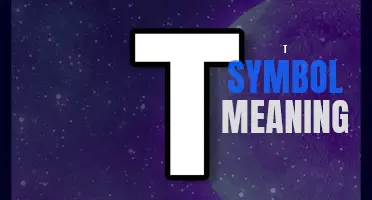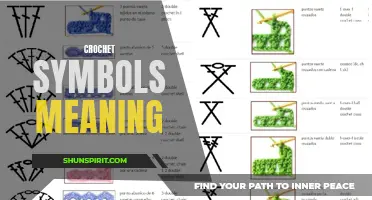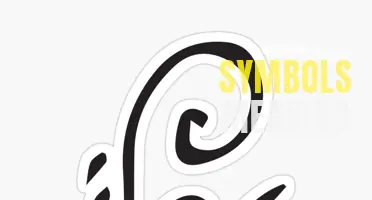
In the world of anime and manga, symbols hold deep and intricate meanings. From simple shapes to complex patterns, each symbol tells its own unique story. One such symbol that has captivated fans and artists alike is the iconic Mitsudomoe symbol. Derived from Japanese folklore and culture, this symbol represents a powerful and significant concept that continues to resonate with people around the world. So, join us on a journey as we unravel the meaning behind the Mitsudomoe symbol and delve into the rich tapestry of its history and symbolism.
What You'll Learn

What is the meaning behind the Mitsudomoe symbol?
The Mitsudomoe symbol, also known as the Tomoe symbol, is a traditional Japanese emblem that consists of three interlocking comma-like shapes. This symbol has deep cultural and spiritual significance and can be found in various aspects of Japanese history and society.
The Mitsudomoe symbol is often associated with the Shinto religion, Japan's indigenous belief system. In Shinto, the symbol represents the three realms of existence: heaven, earth, and humanity. It is believed to embody the interconnectedness and harmony between these realms.
The three comma-shaped swirls of the Mitsudomoe symbol are thought to represent various triads, such as past, present, and future; birth, life, and death; or mind, body, and spirit. The symbol is sometimes associated with the concept of yin and yang, representing the balance and interplay of opposites.
In addition to its religious and philosophical significance, the Mitsudomoe symbol has been used in various other contexts throughout Japanese history. It can be found on ancient artifacts, such as pottery and armor, and has been incorporated into the designs of traditional clothing and architecture. It is also seen in modern culture, including anime, manga, and video games, where it is often used as a decorative motif or as a symbol of strength and protection.
While the Mitsudomoe symbol has deep cultural meaning, it is important to note that its interpretation can vary. Different individuals and groups may associate different significances and interpretations to the symbol, depending on their own beliefs and cultural backgrounds.
In conclusion, the Mitsudomoe symbol is a traditional Japanese emblem that represents the interconnectedness and harmony between heaven, earth, and humanity. Its three comma-shaped swirls symbolize various triads and concepts, and it can be found in various aspects of Japanese history and society. Its usage and interpretation may vary, but it remains an important symbol in Japanese culture.
Decoding Porsche Dashboard Symbols: Understanding the Meaning Behind the Signs
You may want to see also

Where does the Mitsudomoe symbol originate from?
The Mitsudomoe symbol, often recognized as three interlocking swirls, holds a significant cultural and historical background. Originating from Japan, the symbol has deep roots in the country's ancient mythology and traditional beliefs. The Mitsudomoe symbol is frequently displayed in various contexts, including religious rituals, family crests, and even modern pop culture.
The term "Mitsudomoe" translates to "three comma-shaped forms" in English. The symbol itself consists of three swirls or tomoe, each resembling a comma. These tomoe swirls are interconnected, forming a circular shape. The Mitsudomoe symbol is often seen in a clockwise direction, with the swirls moving from the bottom left to the top right.
One of the earliest appearances of the Mitsudomoe symbol can be traced back to Shinto, Japan's indigenous religion. In Shinto, the symbol represents the three kami or divine spirits known as Izanagi, Izanami, and Amaterasu. These deities are integral to the creation myth, as they are responsible for the birth of Japan and the Imperial Family.
The Mitsudomoe symbol's connection to Shinto is further strengthened by its association with Hachiman, the Shinto god of war and divine protector. Hachiman is often depicted wearing a Mitsudomoe emblem on his clothing, symbolizing his divine authority and protection.
Beyond its religious significance, the Mitsudomoe symbol is also found in family crests, known as kamon. Kamon are the emblems used to identify and distinguish different families in Japan. The use of kamon dates back to the Heian period (794-1185), where families would display their crests on clothing, flags, and buildings to signify their social status and lineage. The Mitsudomoe symbol was chosen by certain families as their kamon due to its auspicious meaning and its connection to Shinto beliefs.
In modern times, the Mitsudomoe symbol has been adopted and popularized in various contexts. It has made its way into manga, anime, and video games, gaining recognition among fans of Japanese pop culture worldwide. The symbol is often used to represent themes such as mystery, supernatural powers, or spiritual energy.
In conclusion, the Mitsudomoe symbol has its origins deeply rooted in Japanese mythology and religious beliefs. Its connection to Shinto and its representation of divine spirits make it a significant symbol in Japanese culture. Whether displayed in religious rituals, family crests, or modern pop culture, the Mitsudomoe symbol continues to hold its historical and cultural importance.
Decoding the Dashboard: Understanding John Deere Tractor Symbols and Meanings
You may want to see also

Are there variations of the Mitsudomoe symbol with different meanings?
The Mitsudomoe symbol is a traditional Japanese emblem that has gained popularity and recognition worldwide. With its distinct threefold swirl design, the symbol has been used in various contexts, from religious and cultural to modern-day pop culture. While the symbol itself holds deep significance in Japanese culture, there are indeed variations of the Mitsudomoe symbol, each with its own unique meaning.
The Mitsudomoe symbol is often associated with Shintoism, the indigenous religion of Japan. In Shinto, the symbol represents the three important deities: Amaterasu, the goddess of the sun, Susanoo, the god of the sea and storms, and Tsukuyomi, the god of the moon. It signifies the harmonious balance of these three celestial forces and is considered a symbol of protection and good fortune.
However, outside of its religious significance, the Mitsudomoe symbol has found its way into various forms of Japanese art and culture. In the context of martial arts, the symbol can represent strength, resilience, and unity. It is often used as an emblem on martial arts uniforms or as a design element in training spaces.
Furthermore, in modern popular culture, the Mitsudomoe symbol has become an iconic emblem associated with manga and anime. It is commonly used in the logos of anime series, video games, and merchandise. In this context, the symbol is often seen as a representation of strength, power, and the supernatural.
There are also variations of the Mitsudomoe symbol that incorporate additional elements or modify the original design. For example, some versions may include additional swirls or intricate patterns within each swirl. These variations can be seen as personal interpretations or artistic expressions of the symbol, often used in fashion or as decorative elements.
It is important to note that while the Mitsudomoe symbol has gained popularity and recognition outside of Japan, its meaning and significance may vary depending on the context and personal interpretation. It is always recommended to research and understand the cultural and historical background of any symbol before using it in a particular context.
In conclusion, the Mitsudomoe symbol is a versatile emblem with various meanings and interpretations. From its religious significance in Shintoism to its use in martial arts and pop culture, the symbol has become a recognizable and cherished symbol in Japanese society and beyond. Whether it represents the harmonious balance of celestial forces or simply serves as a design element, the Mitsudomoe symbol continues to captivate and inspire people around the world.
Decoding the Symbols and Meanings of Caterpillar Heavy Equipment
You may want to see also

What cultural significance does the Mitsudomoe symbol hold?
The Mitsudomoe symbol, also known as the "Threefold Tomoe," is a traditional Japanese emblem that holds significant cultural and spiritual meaning. It is often associated with Shintoism, an ancient indigenous religion of Japan. The symbol consists of three comma-shaped swirls, arranged in a circular fashion.
In Shintoism, the Mitsudomoe symbol represents the three fundamental aspects of the universe: heaven, earth, and humanity. Each swirl represents one of these elements, and the interconnection of the three symbolizes the harmony and balance between them. It is believed to represent the cycle of life and the interconnectedness of all things in the universe.
The word "Mitsudomoe" can be roughly translated to "threefold comma," with "Mitsu" meaning three and "Domoe" meaning comma. The term "comma" refers to the shape of each swirl in the symbol, which resembles a comma punctuation mark. This unique design is believed to have originated from ancient divination tools used in Shinto rituals.
In addition to its religious significance, the Mitsudomoe symbol can also be found in various aspects of Japanese culture. It is often seen on traditional garments, such as kimono, as a decorative motif. The symbol is also commonly used in family crests, known as "kamon," to represent a particular family's lineage and ancestry.
Furthermore, the Mitsudomoe symbol has gained popularity outside of Japan and has become a popular design element in contemporary culture. It can be seen in various forms of art, such as paintings, tattoos, and jewelry. It has also been incorporated into modern logo designs, especially in the realm of Japanese pop culture and entertainment.
The Mitsudomoe symbol continues to evoke a sense of mysticism and tradition in Japanese culture. It serves as a visual representation of the deep-rooted spiritual beliefs and values held by the Japanese people. Its presence in various aspects of everyday life and popular culture reflects the enduring influence of traditional symbolism in the modern world.
Understanding the Symbols on the Freestyle Libre 2: A Guide
You may want to see also

How is the Mitsudomoe symbol traditionally used or displayed?
The Mitsudomoe symbol, also known as the Tomoe symbol, is a traditional Japanese design consisting of three interlocking circles. It is a widely-used symbol in Shintoism, Buddhism, and other Japanese traditions, and holds various meanings depending on the context in which it is used.
The Mitsudomoe symbol is traditionally displayed in various ways in Japanese culture. One common usage is as a family crest, known as "mon" in Japanese. These mons are used to identify and distinguish different families or individuals. The Mitsudomoe symbol is considered a powerful and auspicious design, and many families use it as their mon to represent their lineage and heritage.
In addition to being used as a family crest, the Mitsudomoe symbol is also displayed in various religious and spiritual contexts. It is often seen in Shinto shrines and Buddhist temples, where it is believed to bring protection and good fortune. The symbol is sometimes found on ema, small wooden plaques on which people write their wishes and prayers. These ema are then hung up at shrines or temples as a way of sending these wishes and prayers to the divine.
The Mitsudomoe symbol is also used decoratively in Japanese art and design. It can be found on various objects such as ceramics, textiles, and paintings. In this context, the symbol is often seen as a representation of the cycles and interconnectedness of life. The three circles of the Mitsudomoe symbol are said to represent heaven, earth, and humanity, and their interlocking design symbolizes the constant interactions and interdependence of these realms.
In modern times, the Mitsudomoe symbol has gained popularity beyond Japan and is often used in popular culture and fashion. It can be seen on clothing, accessories, and even tattoos. However, it is important to note that the symbol holds deep cultural and religious significance, and its appropriation should be done with respect and understanding of its cultural context.
Overall, the Mitsudomoe symbol is traditionally used and displayed as a family crest, in religious and spiritual contexts, and as a decorative element in Japanese art and design. Its interlocking circles represent the connection and interdependence of different realms, and it is believed to bring protection and good fortune.
The Vital Guide to Understanding Forklift Warning Light Symbols and Their Meanings
You may want to see also
Frequently asked questions
The mitsudomoe symbol, also known as the tomoe symbol, is a traditional Japanese symbol that represents balance and harmony. It is made up of three interlocking comma-shaped figures, forming a circular shape. Each comma represents different concepts such as past, present, and future; birth, life, and death; or heaven, earth, and mankind. The symbol is often seen as a representation of the cycle of life and the interconnectedness of all things.
The mitsudomoe symbol is not associated with any specific religion, but it is frequently used in Shintoism, a traditional Japanese religion. In Shintoism, the symbol is seen as a representation of the threefold division of the world into heaven, earth, and mi







